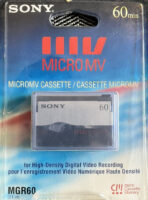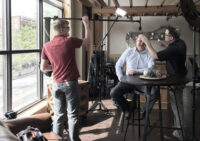In these newly preserved tests, made in 1922 at the Paragon Studios in Fort Lee, New Jersey, actress Mae Murray appears almost translucent, her flesh a pale white that is reminiscent of perfectly sculpted marble, enhanced with touches of color to her lips, eyes, and hair.
She is joined by actress Hope Hampton modeling costumes from The Light in the Dark (1922), which contained the first commercial use of Two-Color Kodachrome in a feature film. Ziegfeld Follies actress Mary Eaton and an unidentified woman and child also appear.”
George Eastman House is the repository for many of the early tests made by the Eastman Kodak Company of their various motion picture film stocks and color processes. The Two-Color Kodachrome Process was an attempt to bring natural lifelike colors to the screen through the photochemical method in a subtractive color system.
First tests on the Two-Color Kodachrome Process were begun in late 1914. Shot with a dual-lens camera, the process recorded filtered images on black/white negative stock, then made black/white separation positives.
The final prints were actually produced by bleaching and tanning a double-coated duplicate negative (made from the positive separations), then dyeing the emulsion green/blue on one side and red on the other. Combined they created a rather ethereal palette of hues.






Editor’s Note: According to Wikipedia, Kodachrome was invented in the 1930’s. One person thinks this could be 2 strip Technicolor Film which combined only Red and Green – no blue.
It sure is beautiful whatever it is!
Could an Eastman or Kodak representative please clarify.
Technically astounding, but I find these films unbearably sad to watch! The more realistic the reproduction, the more profoundly one grieves for a beautiful departed soul. Hey ho, let’s make the best of all our days.
Two-color Kodachrome was around long before the 1930’s. Maybe the Wikipedia article you saw (I have not checked) was about a later Kodachrome process?
See this page for some extra info about the process:
http://www.widescreenmuseum.com/oldcolor/subtract.htm
“This process had no relationship to Eastman Kodak’s marvelous single film color reversal process that was unveiled in 1935.”
I seriously thought these film shorts were shot this week as an artists re-creation of the 1920’s! Wow!
This stuff breaks my heart. Everything we see of that era is always in black-and-white, and often herky-jerky, and so it looks “old-timey”. But to see these people in color is to see them as real. Not artifacts of the period, but real people just like us. But from 90 years ago! Extremely moving!!
The Kodachrome we know today was developed by a couple of amateur photographers and perfected by Eastman in the 30’s –speed:: ASA 10. I have some 1939 chromes as bright as the day they were processed. What a film!
There is an ethereal quality in these images that is created by the film, but perhaps also the tempo of the time. I was moved by the grace and slowness of their gestures.
Somewhere I have photos of a Kodachrome motion picture camera (from a Hollywood history exhibit) with three canisters for black & white film – I think this was from the mid 1940’s ??